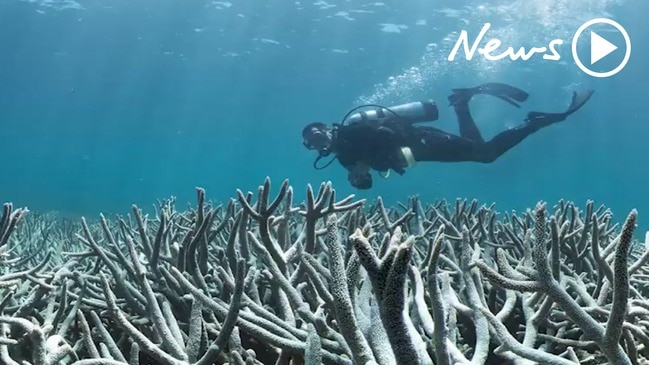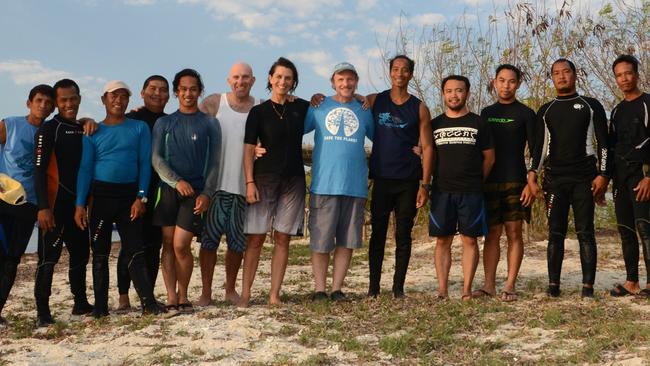Groundbreaking work to save coral reefs involves wedding veils
BRIDES love it and coral could too. Material used to make wedding veils is the key to combating “the international reef crisis”. And it involves coral ‘sex’.

Beaches & Fishing
Don't miss out on the headlines from Beaches & Fishing. Followed categories will be added to My News.
BRIDES love it and coral could too.
Material used to make wedding veils is the key to combating “the international reef crisis”, a Northern NSW coral researcher says.
And it all revolves around preventing the sperm and eggs of coral from floating away into the sea.
In the past few years, Southern Cross University Professor Peter Harrison said he had bred and nurtured 1mm-long larvae to breeding corals roughly the size of dinner plates on reefs damaged by dynamite fishing in the Philippines.

Prof Harrison, who has been researching and researching coral reproduction for 35 years, said his world-first breakthrough could restore marine environments around the world by helping coral have sex more effectively.
Experts warn coral bleaching may have killed up to half of all reef colonies on the Great Barrier Reef in the past two years, with former Australian Institute of Marine Science chief scientist Charlie Veron telling the Gold Coast Bulletin last month the impact was being felt in Gold Coast waters. Dr Veron fears fishing industries will fail worldwide as reefs die from the impact of global warming and ocean acidification.

Prof Harrison said coral spawns in clouds of eggs and sperm that float freely in the water currents, but many missed the reefs altogether.
With $1.2 million from the Australian Centre for International Agricultural Research and a team of local researchers, Prof Harrison said he had managed to capture coral eggs and sperm and breed them in artificial tanks.
The resulting larvae is then placed on the dead or damaged reef and protected by building tents made of organza, the material used in wedding veils and dresses, to protect them from rough seas and being eaten by fish.

“The most successful ideas are when you can make then simple and effective,” Prof Harrison said.
“That’s the best way to tackle the international reef crisis.”
Prof Harrison said the pilot study in the Philippines was promising and could be used throughout the country where people depend on fishing the reefs for their livelihoods.
In coming years he hoped the research could be used in Australian waters, which are equally dependent on the coral and have been hit by coral bleaching, storms and the crown of thorns starfish.
“This is a small pilot study. It has good research capabilities to build capacity to take those ideas and spread them throughout the Philippines,” Prof Harrison said.
“I would like to do this on a larger scale in Australian waters in the next couple of years. I’m excited by the results.
“We have to look after the reefs we have before we scale up.
“Coral reefs are centres of biodiversity. There are millions of species that depend on them as well as the people who live by them.
“The Great Barrier Reef is worth $6 billion each year. The loss of that income is enormous.”
University of Queensland coral researcher Dr Pim Bongaerts said the study was welcome news during a dark time for reefs globally.
“One thing that is really exciting is growing the coral from the egg,” Dr Bongaerts said.
Recent regeneration programs relied on breaking off coral branches and transplanting them throughout reef systems, he said.
Dr Bongaerts said transplanting had drawbacks because it damaged existing reefs and led to “coral clones” weakening genetic diversity.
“A more diverse population means they can be more resistant to bleaching events and storms,” he said.
Dr Bongaerts said he hoped Prof Harrison’s program worked for multiple coral species and could be applied to the Great Barrier Reef.
“The Great Barrier Reef is so highly diverse, if you could only do it with one species it would be like working in a rainforest and planting one tree,” he said.
FACTS
● Harvested eggs and sperm become larvae within about five days in aquaculture tanks.
● A 1mm larvae grows to a dinner plate-size, breeding coral within three years.
● The program can be replicated cheaply across the Philippines and South-East Asia.
● Prof Harrison hopes to bring larger-scale program to Australian waters.
